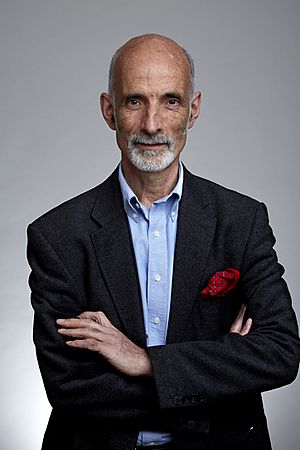Jonathan Ashmore facts for kids
Quick facts for kids
Jonathan Ashmore
FRS FMedSci FRSB
|
|
|---|---|

Ashmore at the Royal Society in 2017
|
|
| Born |
Jonathan Felix Ashmore
1948 (age 76–77) |
| Education | Westminster School |
| Alma mater | University of Sussex (BSc) Imperial College London (PhD) University College London (MSc) |
| Relatives | Rosalie Crutchley (mother) Peter Ashmore (father) |
| Awards | Croonian Lecture (2017) |
| Scientific career | |
| Fields | Hearing Biophysics |
| Institutions | University College London University of Bristol International Centre for Theoretical Physics |
| Thesis | Aspects of quantum field theory (1972) |
| Doctoral advisor | Tom Kibble |
| Other academic advisors | |
| Doctoral students | Dan Jagger |
Jonathan Felix Ashmore (born 1948) is a British physicist and a professor at University College London. He is well-known for his important research into how we hear.
Contents
Early Life and School
Jonathan Ashmore was born in 1948. His parents were both involved in theatre. His father, Peter Ashmore, was a director and actor. His mother, Rosalie Crutchley, was an actress.
When he was seven years old, Jonathan even acted in a movie! He played the character Joe in the 1955 film A Kid for Two Farthings. This movie was based on a book by Wolf Mankowitz.
Jonathan went to Westminster School, a famous school in London. He then studied mathematics and physics at the University of Sussex. Later, he earned his PhD in theoretical physics from Imperial College London in 1971. His research there looked into complex ideas about how the universe works.
Discovering How We Hear
After finishing his studies, Jonathan Ashmore worked as a researcher in Italy. He then decided to focus on how the body works, especially how we hear. He earned another degree from University College London (UCL) in 1974.
He became a professor at the University of Bristol in 1983. Later, in 1993, he returned to UCL.
How Our Ears Work
Professor Ashmore's main research has been about the organ of Corti. This is a special part inside the cochlea, which is shaped like a snail shell in your inner ear. He studied this part in animals like the guinea pig.
He found that our ears have a built-in "cochlear amplifier." This amplifier helps us hear very quiet sounds and tell the difference between different sounds. He discovered that tiny, special cells called outer hair cells are responsible for this amazing ability.
The Magic of Hair Cells
When sound waves enter your ear, these outer hair cells actually change shape! They lengthen and then shorten very quickly. This movement is powered by tiny electrically charged particles called potassium ions. This quick movement helps to make sounds louder and clearer.
Professor Ashmore was the first person to record this amazing process on film. He called his video Rock Around the Clock Hair Cell.
His work uses special tools and computer models to understand hearing at a very tiny level. His discoveries are helping scientists learn more about why some people experience deafness or tinnitus (ringing in the ears).
Awards and Recognition
Because of his important work, Jonathan Ashmore has received many awards.
- In 1996, he was chosen as a Fellow of the Royal Society (FRS). This is a very high honor for scientists in the UK.
- In 2017, he gave the Croonian Lecture, a famous talk about the neuroscience of deafness.
- He is also a member of other important scientific groups, like the Academy of Medical Sciences and the Royal Society of Biology.
- From 2012 to 2014, he was the president of The Physiological Society.
Jonathan Ashmore's research has greatly improved our understanding of how hearing works.

